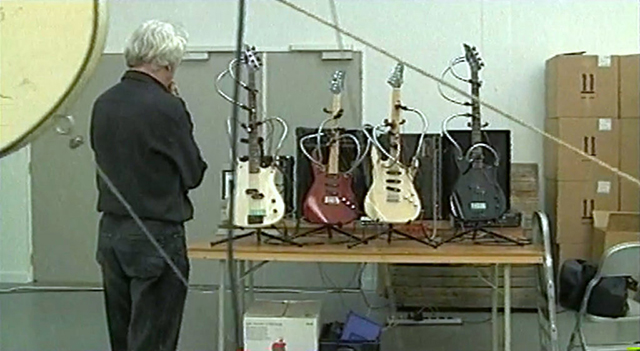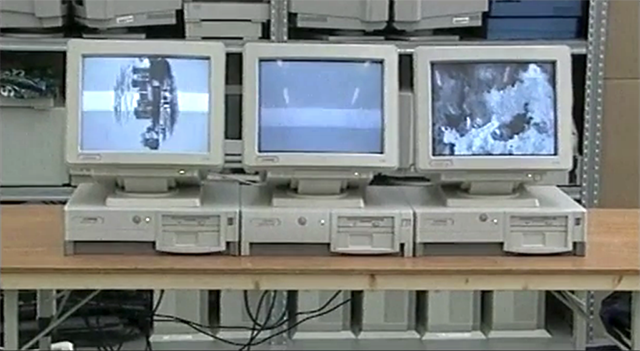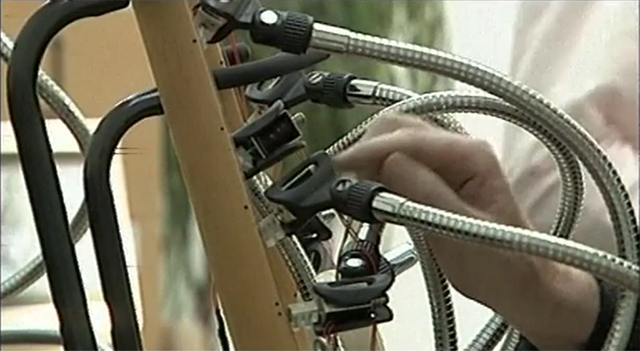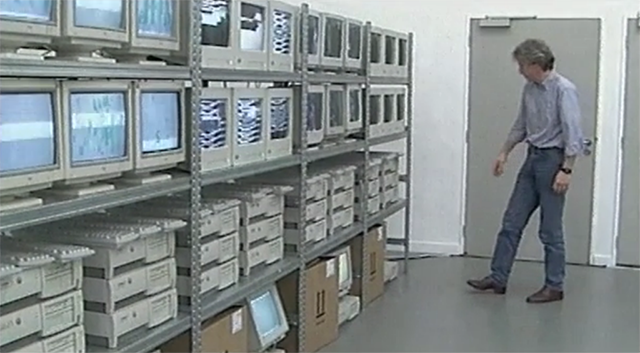title
Institute of Artificial Art Amsterdam (IAAA)
artist
Remko Scha
intro
The Institute of Artificial Art is an independent organisation, founded by Remko Scha, where machines, computers, algorithms, and humans work together toward the complete automation of art production.1 The Institute is led by the fictional character of Huge Harry, a speech robot that was another art project by Remko Scha.
In 1991, Remko Scha wrote the text “Artificial Art”, a plea for computer-generated chance art. Human-made art, he said, was conventional, predictable, and its creativity highly overestimated. With the Institute of Artificial Art, Scha investigated the possibilities of computer generated, algorithmic art, which in his opinion would yield much more surprising results.
The Institute still exists and operates in the fields of visual art, design, architecture, music, performance, and art history. The website of the IAAA contains a large archive of all the artworks, music, computer programs, and texts produced by the organisation.
In 1991, Remko Scha wrote the text “Artificial Art”, a plea for computer-generated chance art. Human-made art, he said, was conventional, predictable, and its creativity highly overestimated. With the Institute of Artificial Art, Scha investigated the possibilities of computer generated, algorithmic art, which in his opinion would yield much more surprising results.
The Institute still exists and operates in the fields of visual art, design, architecture, music, performance, and art history. The website of the IAAA contains a large archive of all the artworks, music, computer programs, and texts produced by the organisation.
biography artist
Remko Scha studied physics at the Technical University of Eindhoven and got his PhD in 1983 in computer linguistics at the University of Groningen. After receiving his PhD, Scha became a professor of computer linguistics at the University of Amsterdam. In addition to his scientific work, he initiated and developed various art projects with an interest in the automation of artistic processes.
He founded Het Apollohuis in 1980 in Eindhoven, which was a space for experimental music, visual art, and the combination of the two: sound art. He wrote many texts on artificial art and why art should be automated; a trend that resulted in the founding of the Institute of Artificial Art.
He founded Het Apollohuis in 1980 in Eindhoven, which was a space for experimental music, visual art, and the combination of the two: sound art. He wrote many texts on artificial art and why art should be automated; a trend that resulted in the founding of the Institute of Artificial Art.
keywords
artificial art, computer art, computer generated art, algorithmic art, machine art, sound art, audiovisual
images
[caption id="attachment_1005" align="alignnone" width="640"] Luuk Bouwman, Huge Harry and the Institute of Artificial Art, 2000. Filmstill[/caption]
[caption id="attachment_1006" align="alignnone" width="640"]
Luuk Bouwman, Huge Harry and the Institute of Artificial Art, 2000. Filmstill[/caption]
[caption id="attachment_1006" align="alignnone" width="640"] Luuk Bouwman, Huge Harry and the Institute of Artificial Art, 2000. Filmstill[/caption]
[caption id="attachment_1007" align="alignnone" width="640"]
Luuk Bouwman, Huge Harry and the Institute of Artificial Art, 2000. Filmstill[/caption]
[caption id="attachment_1007" align="alignnone" width="640"] Luuk Bouwman, Huge Harry and the Institute of Artificial Art, 2000. Filmstill[/caption]
[caption id="attachment_1008" align="alignnone" width="640"]
Luuk Bouwman, Huge Harry and the Institute of Artificial Art, 2000. Filmstill[/caption]
[caption id="attachment_1008" align="alignnone" width="640"] Luuk Bouwman, Huge Harry and the Institute of Artificial Art, 2000. Filmstill[/caption]
Luuk Bouwman, Huge Harry and the Institute of Artificial Art, 2000. Filmstill[/caption]
 Luuk Bouwman, Huge Harry and the Institute of Artificial Art, 2000. Filmstill[/caption]
[caption id="attachment_1006" align="alignnone" width="640"]
Luuk Bouwman, Huge Harry and the Institute of Artificial Art, 2000. Filmstill[/caption]
[caption id="attachment_1006" align="alignnone" width="640"] Luuk Bouwman, Huge Harry and the Institute of Artificial Art, 2000. Filmstill[/caption]
[caption id="attachment_1007" align="alignnone" width="640"]
Luuk Bouwman, Huge Harry and the Institute of Artificial Art, 2000. Filmstill[/caption]
[caption id="attachment_1007" align="alignnone" width="640"] Luuk Bouwman, Huge Harry and the Institute of Artificial Art, 2000. Filmstill[/caption]
[caption id="attachment_1008" align="alignnone" width="640"]
Luuk Bouwman, Huge Harry and the Institute of Artificial Art, 2000. Filmstill[/caption]
[caption id="attachment_1008" align="alignnone" width="640"] Luuk Bouwman, Huge Harry and the Institute of Artificial Art, 2000. Filmstill[/caption]
Luuk Bouwman, Huge Harry and the Institute of Artificial Art, 2000. Filmstill[/caption]
year
1990-present
premiere
The IAAA was founded in 1990, but Remko Scha produced and presented art projects long before that, which later became part of the IAAA, like “the Machines”, a group of electric motors (fans, drills, and sabre saws) that play electric guitars. The Machines have been performing since 1980 and the work was last installed in 2017 at the Vondelbunker in Amsterdam.
software
The IAAA produced computer programs that generated art like “Artificial”, an automatic image generation program, and “Huge Harry”, the speech robot that was the ‘director’ of the IAAA.
functionality
The goal of the IAAA is the the complete automatization of art production.
part of collection
production
The IAAA produced works in the fields of visual art, music, design, and architecture.
hardware
The IAAA uses computers and machines to produce art, music, architecture, and design.
technical specs
intention artistquote by artist
quote
“Because the production of art is left to the arbitrary impulses and shortsighted ambitions of individual artists, most art is conventional and predictable. Human creativity is often overestimated. Well-designed generative algorithms can yield more surprising results than toiling individual artists.
For human persons it is very difficult to survey all possible combinations of a set of items. For this reason, many structures that are implicitly given in the visual language of our cognitive system have never been witnessed yet. The algorithmic exploration of explicit visual grammars will make these structures visible. I imagine the following division of labour: people define the elements and operations of the visual algebra, and thereby specify an infinite combinatorial space; computer programs draw random samples from this space. Progress by human abstraction and machine systematicity—just as in science.
The interpretation of the artwork will be decoupled from all anecdotal information about the artist. Image-generation software will be developed through a collective, analytic, un-expressive effort. Art will not revolve around the individual artist any more. A Copernican turn.”2
For human persons it is very difficult to survey all possible combinations of a set of items. For this reason, many structures that are implicitly given in the visual language of our cognitive system have never been witnessed yet. The algorithmic exploration of explicit visual grammars will make these structures visible. I imagine the following division of labour: people define the elements and operations of the visual algebra, and thereby specify an infinite combinatorial space; computer programs draw random samples from this space. Progress by human abstraction and machine systematicity—just as in science.
The interpretation of the artwork will be decoupled from all anecdotal information about the artist. Image-generation software will be developed through a collective, analytic, un-expressive effort. Art will not revolve around the individual artist any more. A Copernican turn.”2
influence
Remko Scha was clearly influenced by chance art and anti-art, following avant-garde groups and movements such as Dada, Conceptual Art, Performance Art, and Fluxus.
On radicalart.info (part of the IAAA), Remko Scha created an “analytical anthology of anti-art and meta-art”. Here, Scha’s preference for the automatization of art production is substantiated through texts and theories by Immanuel Kant, Marcel Duchamp, Jean Tinguely, John Cage, etc.3 Remko Scha was influenced by theorists such as Arthur Danto, Marius de Zayas, Hegel, Barthes, and Boris Kushner, who all had an anti-artistic position in the way that they declared art dead or accomplished.4
Several artists worked at the Institute, for example Samuel Vriezen and Jochem van der Spek.
On radicalart.info (part of the IAAA), Remko Scha created an “analytical anthology of anti-art and meta-art”. Here, Scha’s preference for the automatization of art production is substantiated through texts and theories by Immanuel Kant, Marcel Duchamp, Jean Tinguely, John Cage, etc.3 Remko Scha was influenced by theorists such as Arthur Danto, Marius de Zayas, Hegel, Barthes, and Boris Kushner, who all had an anti-artistic position in the way that they declared art dead or accomplished.4
Several artists worked at the Institute, for example Samuel Vriezen and Jochem van der Spek.
context
LITERATURE
iaaa.nl - publications: All the writings by IAAA staff are listed here, as well as articles by third parties about the work of the IAAA. The most important articles from or about the IAAA are the following:
Hellings, Lino. "Ongedisciplineerde Kunst in Nederland. Inventarisatie van Theorie en Praktijk." December 2002. www.remkoscha.nl/iaaa (pdf)
Kluitenberg, Eric. "Human Art is Dead. Long Live the Algorithmic Art of the Machine. A Mute exclusive Interview with Huge Harry by Eric Kluitenberg." Mute, no. 19, February 1998. pp. 14-21. Scha, Remko. “Artificial Art.” Remko Scha, 1991, www.remkoscha.nl/iaaa/rs/artkunstE.html. Scha, Remko. “Kant, Duchamp, Meta-Art”. Radical Art, radicalart.info. Tates, Sophie. “Remko Scha & Arthur Elsenaar.” Deep Screen Art in Digital Culture, by Andreas Broeckmann et al., Stedelijk Museum, 2008, pp. 10–11, 55-60
Hellings, Lino. "Ongedisciplineerde Kunst in Nederland. Inventarisatie van Theorie en Praktijk." December 2002. www.remkoscha.nl/iaaa (pdf)
Kluitenberg, Eric. "Human Art is Dead. Long Live the Algorithmic Art of the Machine. A Mute exclusive Interview with Huge Harry by Eric Kluitenberg." Mute, no. 19, February 1998. pp. 14-21. Scha, Remko. “Artificial Art.” Remko Scha, 1991, www.remkoscha.nl/iaaa/rs/artkunstE.html. Scha, Remko. “Kant, Duchamp, Meta-Art”. Radical Art, radicalart.info. Tates, Sophie. “Remko Scha & Arthur Elsenaar.” Deep Screen Art in Digital Culture, by Andreas Broeckmann et al., Stedelijk Museum, 2008, pp. 10–11, 55-60
part of active discussion
scene artists institutes
People that worked at the institute:
Huge Harry (President and spokesmachine)
Luuk Bouwman (Documentary)
Joop van Brakel (Music) Jos de Bruin (Artificial Design)
Alcedo Coenen (Music)
Hein Eberson (Artificial Art)
Boele Klopman (Artificial Art)
Van Lagestein (Music)
Vangelis Lykos (Artificial Art)
Remko Scha (Secretary)
Jochem van der Spek (Automatic Expressionism)
Hans Stibbe (Music)
Eric Vreedenburgh (Architecture)
Samuel Vriezen (Music)
Victor Wentink (Music)
Ellen Zweig (Music)
Huge Harry (President and spokesmachine)
Luuk Bouwman (Documentary)
Joop van Brakel (Music) Jos de Bruin (Artificial Design)
Alcedo Coenen (Music)
Hein Eberson (Artificial Art)
Boele Klopman (Artificial Art)
Van Lagestein (Music)
Vangelis Lykos (Artificial Art)
Remko Scha (Secretary)
Jochem van der Spek (Automatic Expressionism)
Hans Stibbe (Music)
Eric Vreedenburgh (Architecture)
Samuel Vriezen (Music)
Victor Wentink (Music)
Ellen Zweig (Music)
footnote
1 “Institute of Artificial Art Amsterdam.” IAAA, iaaa.nl.
2 Remko Scha, “Artificial Art.” Remko Scha, 1991, remkoscha.nl/iaaa.
3 Radical Art, radicalart.info.
4 “Anti-Artistic Positions # 1: Art Is Wrong.” Radical Art, radicalart.info.
Annie Abrahams
Livinus van de Bundt & Jeep van de Bundt
Driessens & Verstappen (Erwin Driessens and Maria Verstappen)
Yvonne le Grand
Edward Ihnatowicz
JODI (Joan Heemskerk & Dirk Paesmans)
Bas van Koolwijk
Lancel/Maat (Karen Lancel and Hermen Maat)
Jan Robert Leegte
Peter Luining
Martine Neddam
Marnix de Nijs and Edwin van der Heide
Dick Raaijmakers
Joost Rekveld
Remko Scha
Jeffrey Shaw
Debra Solomon
Steina
Peter Struycken
Michel Waisvisz